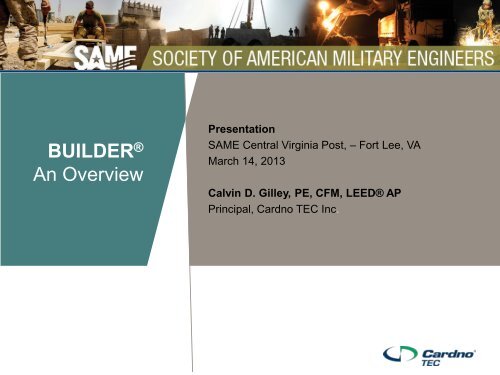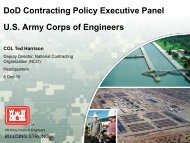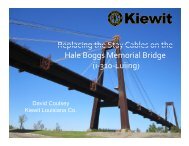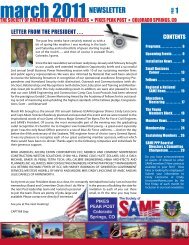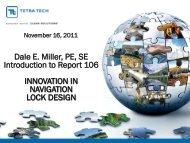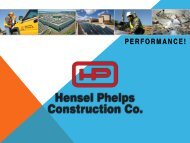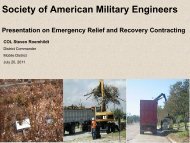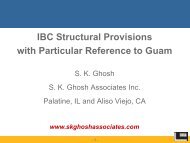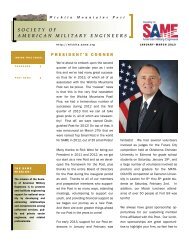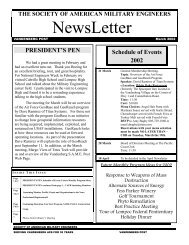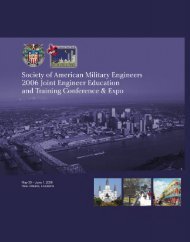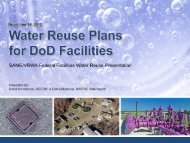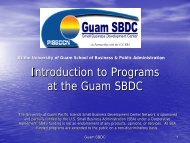BUILDER® An Overview
BUILDER® An Overview
BUILDER® An Overview
Create successful ePaper yourself
Turn your PDF publications into a flip-book with our unique Google optimized e-Paper software.
BUILDER ®<br />
<strong>An</strong> <strong>Overview</strong><br />
Presentation<br />
SAME Central Virginia Post, – Fort Lee, VA<br />
March 14, 2013<br />
Calvin D. Gilley, PE, CFM, LEED® AP<br />
Principal, Cardno TEC Inc.
Presentation Outline<br />
> Asset Management?<br />
> Assessment Systems<br />
> CA Software<br />
> SMS / EMS<br />
> Inventory<br />
> Ratings<br />
> Remaining Service Life<br />
> CI vs. FCI<br />
> BUILDER ® Evolution<br />
> Lessons Learned<br />
> The Way Ahead
Asset Management?<br />
Air Force<br />
> Planning<br />
> Real Property<br />
> Facilities<br />
> Natural Environment<br />
> NEPA<br />
Coast Guard<br />
> Facilities (FE)<br />
> Shore Infrastructure<br />
Logistics<br />
Navy<br />
> Base Development<br />
> Real Property<br />
Marine Corps<br />
> Master Planning<br />
> Real Property<br />
> Facilities (Public Works)
Assessment Systems<br />
> “Traditional” Facility Condition Assessment<br />
– Deficiency Based<br />
– NAVFAC MO 322<br />
– <strong>An</strong>nual Inspection Summary (AIS)<br />
– Fill “Job Jar”<br />
– Five Year Maintenance Action Plan<br />
– One Year Maintenance Execution Plan<br />
> Sustainment Management Systems (SMS)<br />
> Other systems<br />
– Parametric (Whitestone/MARS)<br />
– Economic
CA Software<br />
> “Traditional” Facility Condition Assessment<br />
– VFA Facility (VFA)<br />
– AMS (ISES)<br />
> Sustainment Management Systems (SMS)<br />
– BUILDER ® (ERDC-CERL)<br />
– VERTEX ® (MACTEC/AMEC)<br />
– Comet (Parsons)<br />
– TECfms TM (Cardno TEC Inc.)<br />
> Other Systems – Parametric/Economic<br />
– Whitestone MARS
SMS / EMS<br />
What is a Sustainment Management System?<br />
A lifecycle engineering method which incorporates<br />
observational data collected using a structured<br />
“language” and disciplined inspection procedures to<br />
determine asset condition.
What is BUILDER ® ?<br />
The BUILDER ® Sustainment Management System (SMS) is a web-based software<br />
application developed by ERDC’s Construction Engineering Research Laboratory<br />
(CERL) to help civil engineers, technicians, and managers decide when, where, and<br />
how to best maintain building infrastructure. The process starts with the automated<br />
download of real property data, and then more detailed system inventory is modeled<br />
and/or collected which identifies components and their key life-cycle attributes such as<br />
the age and material. From this inventory, Condition Index (CI) measures for each<br />
component are predicted based on its expected stage in the life-cycle. Objective<br />
and repeatable inspections can then be performed on various components to verify<br />
their condition with respect to the expected life-cycle deterioration. The level of detail<br />
and frequency of these inspections are not fixed like other processes; they are<br />
dependent on knowledge of component criticality, the expected and measured<br />
condition and rate of deterioration, and remaining maintenance and service life. This<br />
“Knowledge-based” inspection focuses attention to the most critical components at the<br />
time.
Inventory<br />
2 Levels of Inventory:<br />
> Asset Level – Individual facilities present in the portfolio, and key<br />
attribute information about each<br />
> Component Level – individual components which make up<br />
systems in a facility. The building blocks of a functioning facility.<br />
Key attribute information is also collected about each component.<br />
– ASTM E1557 Uniformat II
UNIFORMAT II<br />
ASTM E1557<br />
Inventory<br />
Level 1<br />
Level 1<br />
• B<br />
Shell<br />
• D<br />
Services<br />
Level 2<br />
Level 2<br />
• B-30<br />
Roofing<br />
• D20<br />
Plumbing<br />
Level 3<br />
Level 3<br />
• B3010<br />
Roof<br />
Coverings<br />
• D2010<br />
Plumbing<br />
Fixtures<br />
Level 4<br />
Level 4<br />
• B301004<br />
Flashings<br />
& Trim<br />
• D2010006<br />
Water<br />
Fountains
Inventory
Ratings – Distress<br />
> 23 Predetermined types<br />
– Plus ROOFER ® specific types<br />
> Attributed to sub-components<br />
> Severity/density modifiers<br />
> Provide deduct value<br />
> Not “actionable”
Ratings - Direct<br />
> 9 Types<br />
> Measure correlates directly to the distress survey CI scale<br />
> Less effort than a distress survey<br />
> Less objective approach<br />
> Quick record of condition<br />
> Not “actionable”
Ratings - Deficiency<br />
> Problem statement<br />
> Corrective action<br />
> Correction cost<br />
> Priority attribute<br />
> Generate work<br />
> “Actionable”
Remaining Service Life
BUILDER ® SMS<br />
Knowledge Based Inspection (KBI) 1<br />
1 KBI framework and<br />
procedure as<br />
developed by CERL is<br />
protected under US<br />
Patent # US 7,058,544<br />
B2<br />
The goal is NOT to just fill the “job jar,” but maximize inspection value, economically.
CI vs. FCI<br />
Condition Index (CI) Metric<br />
> Provides an objective measure of the physical condition of an<br />
asset based on a 0-100 point scale from a standardized<br />
distress-based, not deficiency-based, inspection process.<br />
Condition Index Descriptor<br />
100-85 Good Slight or no serviceability or reliability reduction<br />
85-70 Satisfactory Serviceability or reliability is degraded but adequate.<br />
70-55 Fair Serviceability or reliability is noticeably degraded<br />
55-40 Poor Significant serviceability or reliability loss.<br />
40-25 Very Poor Unsatisfactory serviceability or reliability reduction<br />
25-10 Serious Extreme serviceability or reliability reduction<br />
10-0 Failed Overall degradation is total.
CI vs. FCI<br />
Facility Condition Index (FCI) Metric<br />
FCI Metric<br />
∑ $ Deficiencies ÷ $ Plant Replacement Value (PRV)<br />
USCG / USN /<br />
USMC<br />
ORGANIZATION<br />
IFMA / NACUBO /<br />
APPA<br />
ARCHITECT OF<br />
THE CAPITAL<br />
Excellent < 0.02<br />
Good < 0.05 < 0.05 0.02 - 0.05<br />
Fair 0.05 - 0.10 0.05 - 0.10 0.05 -0.10<br />
Marginal 0.10 - 0.15<br />
Poor > 0.15 > 0.10 > 0.10
BUILDER ® Output and Benefits<br />
> Long and Short Range Work Action Plans<br />
> Ability to Set Prioritization Criteria and Budget Constraints<br />
> Ability to Run Simulations Based on Current M&R<br />
Decisions<br />
> Lower Cost of Inspection Program by Targeting Projected<br />
System Failures<br />
> Reduced Penalty Costs (Making Decisions at the Right<br />
Time) Allow More Work Accomplishment With the Same<br />
Budget<br />
> System/Component Ratings by Building or Installation
BUILDER ® Output – Sample Report
Army BUILDER ® Evolution<br />
2012 – IMCOM Pilot Project<br />
> Fort Hood, TX<br />
127 Facilities/3,200,000 SF<br />
> Fort Campbell, KY<br />
105 Facilities/2,600,000 SF
3/14/2013<br />
Navy BUILDER ® Evolution<br />
2007 – POM 10 VERTEX TM “Model”<br />
> 28,727 Facilities/320,000,000 SF<br />
2008 – VERTEX Baseline Assessments<br />
2009 – BUILDER ® Selected for Enterprise Life Cycle<br />
<strong>An</strong>alysis and Long Range Work Planning Tool<br />
2009 – Maximo Redirection – BUILDER ® Linkup<br />
2009 – 2011 BUILDER ® Implementation<br />
> Comet Data Collection<br />
> VERTEX TM Conversion<br />
> CIMU Conversion<br />
> BUILDER ® Upload
3/14/2013<br />
USCG BUILDER ® Evolution<br />
2003 - 2005 – MLCPAC Assessments<br />
> TECfms TM<br />
> 7+ Million SF, 10 CONUS/OCONUS Bases<br />
2005 – 2011 District “Experiments”<br />
> VERTEX TM<br />
> VFA Facility<br />
> BUILDER ®<br />
> Traditional FCAs<br />
2007 – Maximo Roll Out (SAMS)<br />
2009 – 2010 TEC ARMR PoC and Implementation<br />
2010 – 2011 CG Information Management Strategy<br />
2011 – 2012 CG Housing “re-set”, PoC USCG IM Strategy
3/14/2013<br />
USMC BUILDER ® Evolution<br />
BUILDER ® v2.2 (2005-2007)<br />
MCB Lejeune MCAS Pendleton<br />
<strong>BUILDER®</strong> v3.0 I - III (9/2007 - 10/2011)<br />
MCB Hawaii MCB/MCAF Quantico<br />
MCRD San Diego MCLB Albany<br />
MCAS Miramar MCAS Cherry Point<br />
MCLB Barstow MCAS New River<br />
MCB Twenty-nine Palms MCRD Parris Island<br />
MCB Lejeune MCB Camp Pendleton<br />
<strong>BUILDER®</strong> v3.0 IV - Japan (10/2011 – 9/2012)<br />
Marine Bases – Japan/Okinawa Refresh MCLB Barstow<br />
<strong>BUILDER®</strong> v3.0 V (2013+)<br />
Refresh ?<br />
TOTAL SF = +/- 90 Million
3/14/2013<br />
USAF BUILDER ® Evolution<br />
2009 – AF Nuclear Program<br />
> 7+ Million SF, 10 CONUS/OCONUS Bases<br />
2010 – PACAF Sustainability Assessments<br />
> Comet<br />
> Energy Audit (ASHRAE Level II)<br />
> Space Optimization<br />
2011/2012 – AF SIA I and SIA II<br />
> 6-8 Contract “Packages”<br />
> Approximately 10 Million SF each<br />
> BUILDER ®<br />
> Energy Audit (ASHRAE Level II)<br />
> Space Optimization<br />
> High Performance Building Audits
Lessons Learned<br />
Public Works Staff Should Understand<br />
> The difference between CI and FCI<br />
> That BUILDER ® does not generate projects<br />
– There must be validation before going to PWS, DD1391 or<br />
Service Call.<br />
> That BUILDER ® operates using distresses and direct<br />
ratings. It does not find deficiencies.<br />
> The difference between CI and Functionality.
Lessons Learned<br />
Before Assessment<br />
> Calibrate the Staff<br />
> Calibration = Data Consistency<br />
> Data consistency allows comparison of identical<br />
information between bases<br />
> Data Consistency = Reliable Data<br />
> Reliable Data = Happy HQ
Lessons Learned<br />
During Assessments<br />
> Coordinate Daily/Weekly Assessments<br />
– Triple Check<br />
> Proper inventory is key<br />
– Know Uniformat II (ASTM E 1557)<br />
– Inventory Drives Forecasting<br />
> Data management and “chain of custody” are critical<br />
> Photos invaluable and of immediate benefit to PWD<br />
> QC is CRITICAL<br />
> Data QC is as important as field QC
Lessons Learned
Lessons Learned<br />
Program Sustainment<br />
> Adjust PW Business Processes<br />
– Standardized Template<br />
– Flexibility for PW Operational Differences<br />
– Standardized Reports<br />
> Training for PW personnel is a must<br />
– Data “half life”<br />
– Return on Investment<br />
> Help Desk<br />
– Special Reports<br />
> Access via NMCI Remains a Challenge
The Way Ahead<br />
> Selective Data Validation<br />
> Data Maintenance / Update<br />
> “Intelligent” assessments<br />
– Save assessment dollars with targeted assessments based on<br />
estimated RSL or CI versus assessing entire inventory every 3-<br />
5 years<br />
> Integration w/USMCmax<br />
– Observing/learning from USN experience<br />
– Observing/learning from USCG SAMS and IMS Strategy<br />
> Integration w/USAF NEXGEN IT<br />
– Observing/learning from SIA I<br />
– Observing/learning from Navy/USMC BUILDER ®<br />
Implementation
Questions/<br />
Discussion<br />
Contact:<br />
Calvin D. Gilley, PE, CFM, LEED ® AP<br />
Principal<br />
Or<br />
Raymond K. Best, PE, LEED ® AP<br />
Principal<br />
2496 Old Ivy Road, Suite 300<br />
Charlottesville, VA 22903<br />
calvin.gilley@cardnotec.com<br />
ray.best@cardnotec.com<br />
www.cardnotec.com<br />
(434) 295-4446


